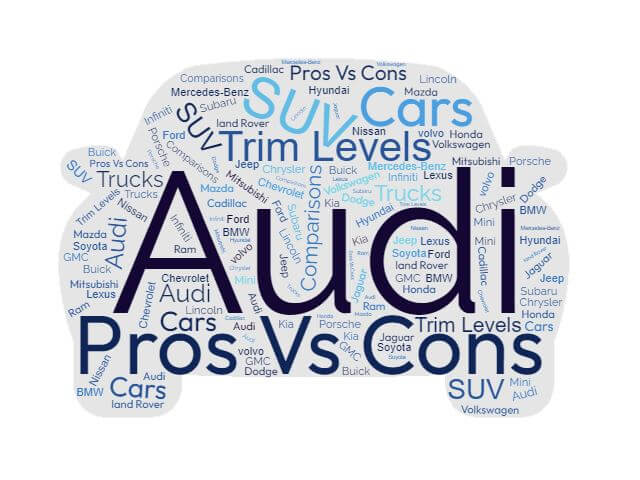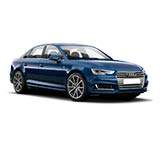Audi

About Audi
Today, Audi is known for building world-class luxury cars that rival anything from its German rivals, but getting to that point involved mergers, lawsuits, secret engineering and a world war.
Finding a Name
August Horch founded August Horch & Cie. Motorwagenwerke, but after disputes with the company's chief financial officer, he left to found a new company. He tried using the name "August Horch Automobilwerke," but his old company sued for trademark infringement.
A meeting was held at Franz Fikentscher's apartment to figure out a new name, and it just so happened that Fikentscher's son was in the room studying Latin. Since "Horch" means "listen" in German, the boy suggested they use the Latin term, "audi." Horch and his associates thought this was a great idea, reestablishing the company in 1910 under the name "Audi Automobilwerke."
The Four Rings
By 1932, DKW was heavily invested in Audi who had merged with Horch and Wanderer. This brand group became known as “Auto Union,” which used four rings to represent each brand. At first, this logo was only used on the company's race cars.
A New Start
At the end of the WWII, Auto Union's factories were taken over by the Russians who established Automobilwerk Zwickau which produced the infamous Trabant, a tiny car with cotton-based plastic body panels that were often eaten by farm animals.
Meanwhile, a new Auto Union company was established in West Germany using a combination of loans from the Bavarian state government and funds from the Marshall Plan. The new company relaunched DKW to provide low cost cars powered by simple two-stroke engines for post-war Germany.
Audi Returns
Daimler-Benz took over Auto Union in 1958, but they were never able to make DKW profitable despite fully modernizing the factory. They eventually sold their stake to Volkswagen. With the German economy back on its feet, buyers wanted smoother four stroke engines, but DKW was strongly associated with two strokes. VW decided to release their upcoming four-stroke model under the name "Audi," reusing the old Auto Union four ring badge.
VW intended to switch the factory over to Beetle production as soon as the Audi ran its course. Auto Union's management launched a secret development project to save the brand. When the prototype was presented to VW chief Heinz Nordhoff, he was so impressed that he immediately agreed to put the car into production as the “100.” Auto Union merged with NSU, giving it the engineering and factory capacity to become an autonomous company. NSU production ended in 1978, and in 1985, the company officially became Audi AG.
Dominating Racetracks to Establish the Brand
Through the 70s, Audis and Volkswagens shared both market segments and designs. The Audi 50 would serve as the base for the immensely popular VW Golf, but it was a mix of Auto Union and VW technology that gave Audi its own identity.
To supply the German military with a small off-roader, VW updated the DKW Mungus with their own technnology to create the Iltis. Chassis engineer Jörg Bensinger saw the vehicle's new four wheel drive system and proposed a version for production cars. The result was the Quattro, an Audi 80 fitted with the system and a turbocharged 5 cylinder. Its power and superior traction gave it a huge advantage over its competition in the World Rally Championship, forcing competitors to come up with their own AWD systems. Race fans and buyers took notice.
Unintended Acceleration
Audi reached the U.S. in 1980, but by 1986 there were accusations that the 5000 would leap forward unexpectedly, resulting in accidents. "60 Minutes" ran a news segment on the problem, re-enacting the event with footage of a driverless 5000 idling and then suddenly moving forward on its own. It was later revealed that the clip was staged using a hidden pneumatic device to shift the transmission into "Drive." However, the damage had been done with sales falling by almost 70%.
It wasn't until 2012 that the NHSTA finally ruled the problem to be due to a combination of driver error, a faulty idle stabilization system and a small brake pedal. After shifting out of park, a change in idle speed would cause the vehicle to lurch forward. Panicking drivers would slam their foot down on a pedal, but often they'd hit the gas instead of the brake.
Becoming a Major Luxury Brand
Audi started separating themselves from Volkswagen with the introduction of their first V8 in 1990. Over time, they've built a collection of luxury cars to compete in popular segments, as well as unique models like the TT roadster and R8 Supercar. They continue to lead in technology, bringing together the Quattro system with lightweight materials to build cars with lower weight and better fuel economy than their two wheel drive competitors. That same expertise has also led to dominance at Le Mans, taking first place 13 times in the past 15 years.








